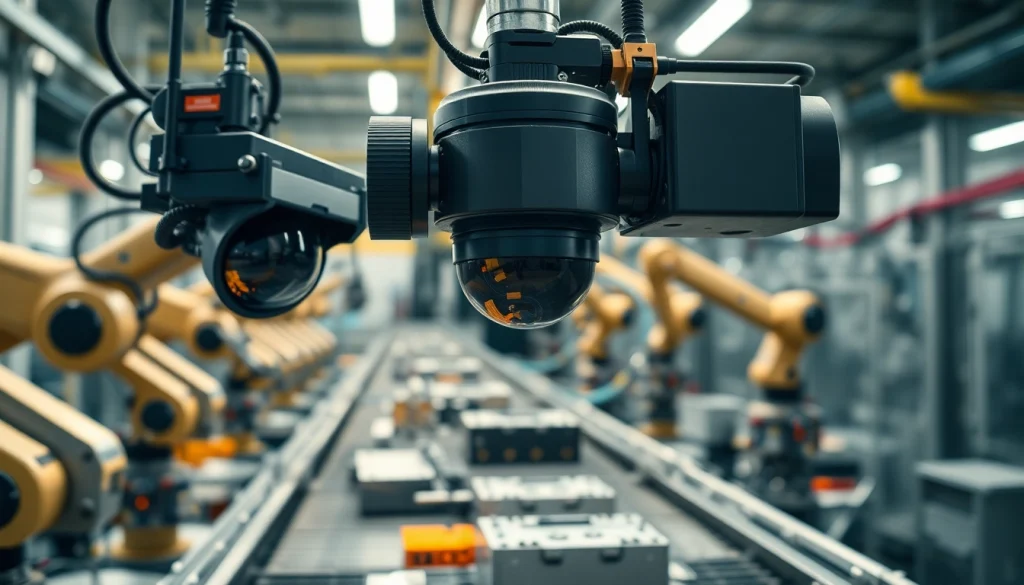What is Machine Vision?
Definition and Core Concepts
Machine vision refers to the technology and techniques used to provide imaging-based automatic inspection, analysis, and control for various applications in industrial and consumer sectors alike. By leveraging cameras, sensors, and artificial intelligence software, machine vision systems capture and interpret visual information, enabling machines to ‘see’ and make decisions based on this data. The machine vision systems have evolved significantly, incorporating advanced algorithms and deep learning methodologies to enhance precision and efficacy in numerous fields.
Historical Development of Machine Vision
The roots of machine vision can be traced back to the early 1960s when researchers began exploring ways to automate visual inspections. Initially, machine vision systems relied heavily on simple rule-based algorithms and primitive imaging techniques. However, as technology progressed, so did the capabilities of these systems. By the 1980s, advancements in computer processing power and the advent of digital imaging allowed for more sophisticated machine vision systems. The integration of artificial intelligence in the late 1990s and early 2000s marked a significant leap, enabling machines to not only capture images but also analyze and learn from them. Today, machine vision is a prominent component of Industry 4.0, seamlessly blending with IoT and automation technologies.
How Machine Vision Works
At its core, machine vision comprises three critical components: image acquisition, image processing, and decision-making. The process begins with image acquisition, where cameras equipped with various lenses capture visual data from objects or scenes. These images are then transferred to a processing unit, where they undergo transformations via hardware and software algorithms. Techniques such as pattern recognition, optical character recognition (OCR), and deep learning are employed to analyze the data. Finally, the system makes decisions based on predefined criteria, such as flagging defects or guiding robotic mechanisms in assembly lines. This multifaceted approach not only optimizes productivity but also enhances quality assurance protocols.
Applications of Machine Vision
Industrial Applications in Quality Control
One of the most common applications of machine vision is in quality control across manufacturing processes. By employing machine vision systems, industries can conduct real-time inspections to detect defects, measure dimensional accuracy, and verify product assembly.
For example, automotive manufacturers use machine vision to inspect components for surface defects, ensuring only flawless parts make it to assembly. With the aid of high-resolution cameras and well-trained algorithms, defects as small as a few micrometers can be detected.
Machine Vision in Autonomous Systems
The integration of machine vision in autonomous systems is transforming industries such as logistics, agriculture, and transportation. In autonomous vehicles, advanced machine vision systems are utilized to detect and recognize obstacles, road signs, and lane markings. This is critical for safe navigation and operation.
In agriculture, machine vision assists in monitoring crop health through aerial imaging and ground-based sensors. This data helps farmers make informed decisions about irrigation, fertilization, and harvesting, thereby optimizing yield and reducing wastage.
Consumer Products and Retail Innovations
Machine vision technology is also finding its way into consumer products and retail environments. Smart cameras equipped with machine vision can assist in various applications, including facial recognition for secure customer interactions or identity verification in payment systems.
In retail, machine vision is used to track inventory levels on shelves, ensuring that stock is replenished promptly and efficiently. This not only improves the consumer shopping experience but also drives operational efficiency for businesses.
Benefits of Implementing Machine Vision
Enhancing Quality and Consistency
One of the primary benefits of machine vision is its ability to enhance the quality and consistency of products and processes. By automating inspections, businesses can significantly reduce human error, ensuring that only products that meet stringent quality benchmarks are dispatched. This level of precision can also lead to increased customer satisfaction and trust in brands.
Cost Reduction and Efficiency Improvement
Cost reduction is a significant advantage of adopting machine vision. By streamlining quality inspections and enhancing process monitoring, companies can decrease labor costs while maximizing throughput. Moreover, quick and accurate detection of defects means that issues can be resolved before they escalate into larger, more costly problems. Overall, this contributes to a smoother, more efficient production pipeline.
Data Collection and Analysis Advantages
Machine vision systems generate vast amounts of data that can be utilized for further analysis. This data is invaluable for trend analysis, predictive maintenance, and process optimization. Businesses can leverage insights gleaned from historical data to enhance product designs and processes, leading to continuous improvement cycles that benefit the organization at all levels.
Challenges in Machine Vision Implementation
Technical Limitations and Solutions
Despite its advantages, implementing machine vision can come with challenges. Technical limitations such as inadequate image resolution, poor lighting conditions, and the complexity of processing algorithms can hinder performance. To address these issues, companies can invest in high-quality imaging sensors, optimize illumination with LED-based light sources, and employ machine learning techniques to enhance image understanding.
Integration with Existing Systems
Integrating machine vision systems into existing workflows can be a daunting task. Compatibility issues and disrupted processes can pose significant obstacles. Successful implementation often requires a thorough analysis of current systems, followed by careful planning and staged integration. Utilizing middleware solutions can facilitate communication between existing systems and new machine vision platforms, ensuring a smoother transition.
Workforce Training and Adaptation
Introducing machine vision technology necessitates a shift in workforce skills and training. Employees must be educated on new tools, systems, and processes. Organizations should invest in comprehensive training programs that cover both operational aspects and basic troubleshooting. Fostering a culture of adaptability within the workforce is essential, as it encourages continuous learning and a proactive attitude towards embracing new technologies.
Future Trends in Machine Vision Technology
Advancements in AI and Deep Learning
The future of machine vision is intricately tied to advancements in artificial intelligence and deep learning. These technologies are poised to redefine the capabilities of machine vision systems, enabling them to perform complex analytical tasks previously thought impossible. As algorithms improve and processing power becomes more sophisticated, we can expect machine vision systems to learn from their failures and successes, continuously refining their accuracy over time.
Expansion into New Industries
While machine vision is already widely used in manufacturing and logistics, new sectors are beginning to explore its potential. Industries like healthcare, where machine vision systems can assist in diagnostic imaging, and construction, where it can facilitate site monitoring, present new opportunities for implementation. As technology evolves, machine vision’s applicability will span a growing number of industries.
Ethical Considerations and Regulations
The expansion of machine vision also raises ethical questions and regulatory considerations. Privacy concerns, especially regarding facial recognition technologies, call for a careful balance between innovation and societal impact. Future regulations will likely aim to regulate the use of machine vision technologies, ensuring that ethical standards are maintained while still promoting technological advancement.


